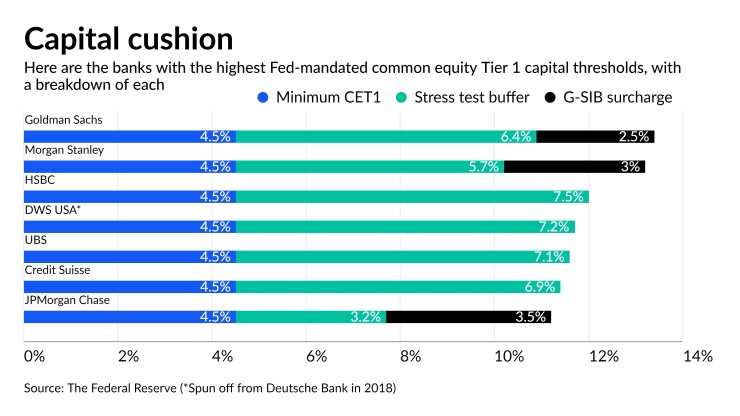WASHINGTON — The Federal Reserve has published capital requirements for the largest banks it supervises that will kick in Oct. 1.
Goldman Sachs will have to comply with the highest capital requirements out of all of

The common equity Tier 1 capital requirement is made up of the minimum CET1 capital ratio of 4.5%, which applies to each of the 34 banks, combined with the stress capital buffer requirement and, if applicable, a surcharge for the eight U.S.-based global systemically important banks.
The stress capital buffer — which the Fed finalized last year — is calculated as the difference between a bank’s starting and projected capital ratios under the “severely adverse” stress-test scenario. The buffer also factors in a bank's common stock dividends as a percentage of risk-weighted assets.
Morgan Stanley will be required to comply with the second-highest capital requirements after Goldman Sachs with a CET1 requirement of 13.2%. HSBC North America has the highest capital requirement among non-U.S. GSIBs at 12%.
The lowest capital requirements are 7% for American Express, Capital One Financial, Fifth Third Bancorp, Huntington Bancshares, KeyCorp, M&T Bank, Northern Trust, PNC Financial Services Group, Regions Financial, Santander Holdings USA, TD Group, Truist Financial and U.S. Bancorp.
State Street has the lowest capital requirements out of the eight GSIBs at 8%, followed by Bank of New York Mellon at 8.5%.
In a release, the Fed also said that HSBC had requested reconsideration of its stress-test results after they were published in June, but that the central bank had upheld those results after an independent group reviewed them. The Fed also directed its staff to “conduct a closer examination of issues raised in the reconsideration process” to further improve its stress-test methodology going forward.




